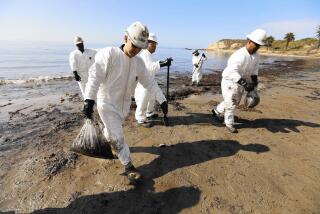Keystone XL pipeline prepares for start-up of southern section
About 3 million barrels of crude are being loaded into the southern section of the Keystone XL pipeline as operators prepare to start operations next month, even as environmental critics continue to assail the safety of the project and lament legal setbacks that allowed the project to move forward.
TransCanada, the Alberta-based pipeline company, announced Tuesday that it would begin shipping oil on Jan. 22 on its Gulf Coast project, a 485-mile pipeline that forms the southern section of the XL from Cushing, Okla., to Texas.
The company built the southern leg of its Keystone XL after the northern section from the Alberta tar sands fields met massive opposition by environmentalists five years ago and became held up in lengthy environmental reviews by the U.S. State Department.
Construction on the southern leg of the system, which required only state environmental permits and permission by the U.S. Army Corps of Engineers to cross hundreds of waterways, was started two years ago, TransCanada spokesman Shawn Howard said.
The Sierra Club sought an injunction against that portion of the project, arguing that the corps failed to properly evaluate the potential risks of the pipeline, including leaks and subsequent pollution of waterways. A federal court denied the injunction, but the suit is continuing, said Eddie Scher, a spokesman for the organization’s Beyond Oil campaign.
It will take about one month to fill the underground pipeline and conduct various tests and safety checks. Howard said the company would not disclose the origin of the crude in the pipeline, but it does connect with the tar sands fields through an existing pipeline.
“This pipeline will be the safest in North America,” Howard said, citing more than two dozen design features that exceed federal requirements.
The pipeline was intended to help relieve a bottleneck in capacity at Cushing, where pipelines meet on the way to refineries along the Gulf Coast. TransCanada has said the additional capacity will help displace imports from South America and the Middle East, allowing refineries to take advantage of their ability to refine both heavy and light crudes from North America.
Scher said, however, that the main intent of moving tar sands oil to the Gulf of Mexico was to help Canada reach international markets and that U.S. refineries already have a glut of crude they are trying to work off.
The Sierra Club contends that the Alberta oil is more dangerous to transport than other crude, because it comprises oil suspended in rock that is abrasive and so thick that it must be pumped at higher-than-normal pressures.
“A prick hole in the pipeline is a major problem,” Scher said.
TransCanada says such claims about abrasion risks are intended to mislead and alarm the public and cites academic studies that show otherwise.
“Oil is oil,” Howard said, adding that the new system will operate at the same pressures as other pipelines.
The pipeline will not help transport crude from the burgeoning fields in North Dakota and Montana, which is largely reaching markets by rail. Petroleum transport experts say that pipelines are twice as safe as moving oil aboard trains, pointing to the derailment in Lac- Megantic, Quebec, this year that killed more than 40 residents.
Transporting oil from the Bakken field in North Dakota by pipeline to the Gulf Coast will require completion of the northern segment of the Keystone XL.
The XL project was envisioned as two segments, with the much longer one carrying Canadian crude from Alberta to Steele City, Neb. After encountering opposition, TransCanada rerouted that segment away from the environmentally sensitive Sandhills area in Nebraska. The project is now under final environmental review by the State Department.
ALSO:
Colorado school shooting: Gunman targeted 5 areas, sheriff says
Ohio murder suspect made 911 call about missing 9-year-old victim
Justice Dept. to give $1.5 million for Newtown relief efforts
More to Read
Sign up for Essential California
The most important California stories and recommendations in your inbox every morning.
You may occasionally receive promotional content from the Los Angeles Times.











